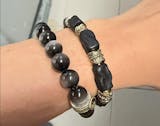Explore The Tibetan Nine-Eye Dzi Beads
In the world of Tibetan culture, Dzi bead (Tib. གཟི།; pronounced "zee"; alternative spelling: gzi) is a type of stone bead of uncertain origin worn as part of a necklace and sometimes as a bracelet.
Dzi beads are often regarded as divine treasures bestowed upon humankind by celestial beings. According to Vedic scriptures, they symbolize unparalleled power and enigmatic forces. Legend has it that in the early days, disciples of Tibetan Buddhism embarked on arduous journeys to Nepal in search of spiritual guidance. To ensure their safety and well-being, they were bestowed with Dzi beads by their masters, believing these beads to offer divine protection and blessings.

Crafted primarily from a semi-precious stone called "agate," Dzi beads are primarily sourced from regions such as Tibet, eastern Tibet, and Ladakh. They contain elements of jade and onyx, although they do not quite reach the level of onyx in terms of hardness. Dzi beads hold a special place in Tibetan culture, classified among the seven treasures of Tibetan Buddhism, along with other sacred items such as tangkas, tridacna, amber, turquoise, coral, and gold. Among these treasures, Dzi beads reign supreme, with locals around the Himalayan region considering them gifts from the heavens.
To delve deeper into this subject, you might be interested in What are Dzi Beads.
The patterns on Dzi beads often feature "eyes," and their value increases with the number of eyes they possess, ranging from one to nine. However, there are also Dzi beads with twelve or eighteen eyes. The significance of the nine-eyed Dzi bead lies in Chinese culture, where the number nine represents an insurmountable boundary. In Tibetan Buddhism, nine symbolizes an infinite realm, encompassing all symbols and concepts imbued with mystical powers. Hence, the nine-eyed Dzi bead holds the utmost value and is hailed as the king of Dzi beads.
Nine-Eye Dzi Bead is the symbol of The Nine Planets, It includes the activity of the Universe and the wisdom of the humanity. Nine-eyed beads is the most popular of all Dzis, brings all kinds of luck and blessings; protection, good health, purify negative energy expand intelligence and wisdom.It helps the investors with the successful development of new ideas in rolling in wealth. Available in black, red, brown, and green.

Crafting a Tibetan Nine-Eye Dzi bead involves a series of intricate steps:
- Material Selection: High-quality stones are meticulously chosen as the raw material for crafting Dzi beads. These stones are typically sourced from specific mineral deposits in regions such as Tibet, Nepal, or India. The quality of the stone directly impacts the efficacy and quality of the Dzi bead.
- Carving Technique: Skilled artisans carve intricate patterns onto the surface of the chosen stone, adhering to traditional designs and symbolism associated with Dzi beads. These patterns are believed to convey mystical meanings and symbolism.
- Processing and Polishing: After carving, the Dzi bead undergoes a series of processing and polishing techniques to achieve a smooth and refined surface, enhancing its luster and aesthetics.
- Drilling: A small hole is carefully drilled at the center of the Dzi bead to facilitate attachment to necklaces or bracelets. Precision is crucial to ensure the hole's alignment and size meet design specifications.
- Cleansing and Blessing: Once completed, the Dzi bead undergoes a ritual cleansing and blessing ceremony. Cleansing removes any residual dust or impurities from the manufacturing process, while blessing imbues the Dzi bead with sacred energy and significance.

It's important to note that crafting Tibetan Dzi beads involves ancient and mystical techniques, with many skills and knowledge passed down through generations of skilled artisans. Thus, the production of Dzi beads transcends mere craftsmanship, embodying profound cultural heritage and religious symbolism.
Related Articles:
Explore the Rich Diversity of Tibetan Bracelets
The Benefits of Wearing a Buddhist Mantra Bracelets
Exploring the Meaning Behind Dragon-Shaped Jewelry
What Are Mala Beads Use For and Why Are There 108 Beads on a Mala
Types and Identification of Bodhi Seed Mala Bracelets

























































